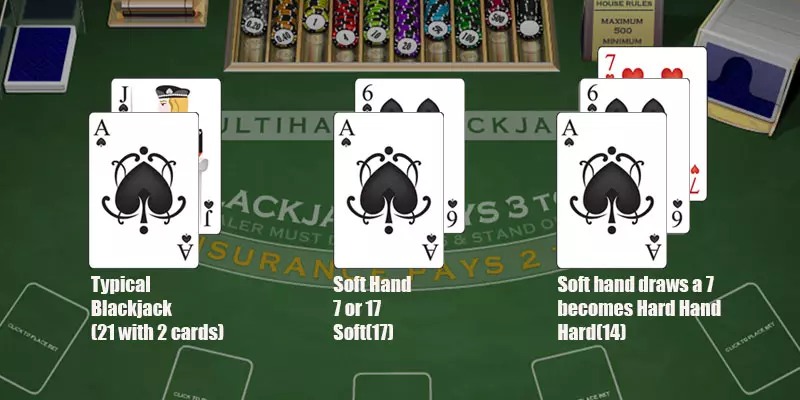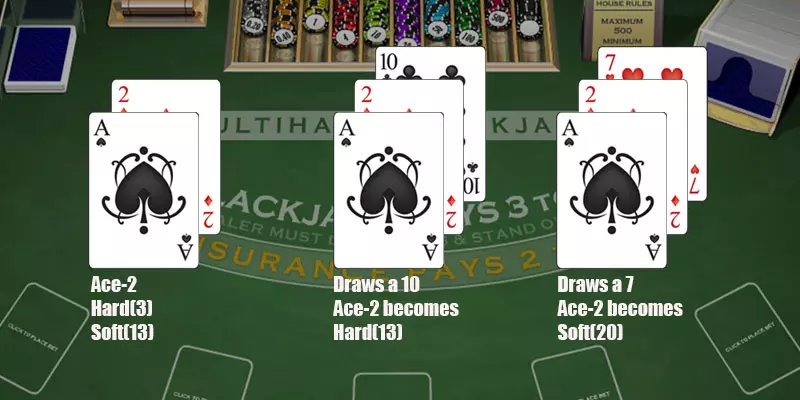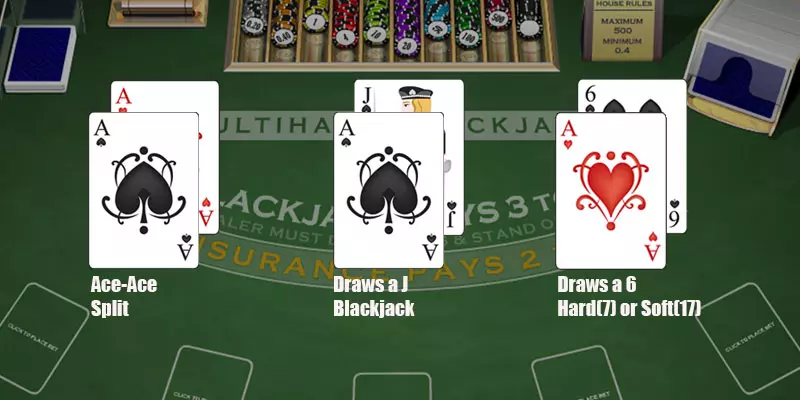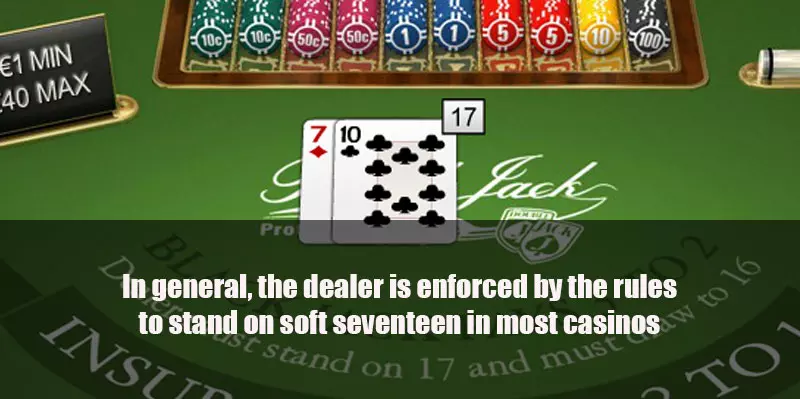Hard and soft hands are very common terms in blackjack and they play a crucial role in the game. However, sometimes even experienced players do not know what these terms mean. They struggle to give an explanation and identify them. As already mentioned, knowing the rules of the game and its glossary is extremely important for players who strive to win.
The same goes for every other casino game. The reason why a game’s rules were established in the first place is to be followed. Moreover, as casino games involve money, it is simply not rational for the players to go to a gaming house and bet all of their available funds without having any strategy or knowledge of the game.
Many of them justify themselves by saying that they play because it’s fun and they don’t have any regrets for the lost money. These are delusions which prevent them from seeing the reality – their money is irretrievably lost and there is nothing fun about that, especially if the sum is huge.
Professional players, whose first priority is to win, know that they can only do so, only if they have a strategy, discipline, money management skills, and, of course, a bit of luck. This is the reason why they are familiar with every rule and subtlety of the game as well. When the appropriate situation occurs, they are prepared to act accordingly and apply the acquired knowledge.
Definition of Hard & Soft Hands
The terms hard and soft hands are actually very easy to understand. It is a shame that so many players do not get familiar with them. A hard hand is one that either has no aces, or if it has, the ace is no longer flexible and is assigned a value of 1 only. Examples of hard hands include K-8, 9-8, 5-10, Q-6, 7-6-2, J-3-5, and 6-A-Q.
Pay attention to the last example with the hard 17 that contains an ace. The key thing here is that this hand initially started as a soft 17, with the player having the option to treat it either as 7 or as 17.

However, the ace lost its flexibility on the next hit as the player drew a ten-value card that would have caused them to bust had the ace been counted as 11. Instead, the ace automatically transitioned to a value of 1 to prevent the bust.
Generally speaking, professional gamblers refer to the term soft hand when they have an ace which is valued 11 or 1 in their hand. Soft hands are very beneficial and the reason behind this is simple – having a flexible ace means that you cannot go bust when you take an additional card as by having one, regardless of its value. You can never exceed 21 when starting with a soft hand.
The ace is the most powerful card in the deck and it allows players to change the total of their hand accordingly throughout the game. Once the conversion from soft to hard total occurs, players stand decent chances of busting as is the case with A-3-2-Q-9, for example.
This hand was originally a soft 14/4 and then it became soft 16/6. Eventually, the ace lost its flexibility after the Queen was drawn for a hard 16. Our hypothetical player took another hit against a strong dealer upcard in line with basic strategy, pulled out a 9, and busted with a total of 25. Another example is A-5-9-K where the same thing happened.
Important Things to Consider
Like every card game, blackjack has a number of card combinations that form different hands and lead to particular outcomes. This is the reason why there are many ways and situations in which players can have soft or hard hands.
It is really important to pay special attention to such cases as they will give players the needed preparation. If they know the possible outcomes a particular action might result in, you have better chances of reducing the advantage of the casino as this allows them to think ahead to the dealer’s next turn.
It is of extreme importance for players to make a distinction between hard and soft totals, the chief reason being there are differences in the basic strategy moves for the two types of hands. A soft total of 13 against the dealer’s 5 is played differently than hard 13.
In the first case, you double down on your soft 13 against this dealer upcard. In the second scenario, you stand since the dealer is in a weak spot when starting with a 5 and stands better chances of busting. Many inexperienced players approach soft hands the same way they play hard ones, and imminently register greater losses over the long term.
Blackjack Rules
Blackjack Variations
Blackjack House Edge
Blackjack Odds and Probabilities
Blackjack Soft & Hard Hands
Playing Hard Hands
Hard standing refers to the cases where players have the respective hand and need to make a choice whether to ‘stand or not’. In such situations, they should be extra careful in order to make the best possible decision which should be based on the total value of the cards in their hand and the dealer’s up card. For instance, if they have a total of eleven or less, they should avoid standing but if their total is at least twelve, it is recommended to stand.
With that said, it is also worthwhile mentioning that the decisions for some hard totals may differ based on the game’s exact rules and playing conditions. Some of the things that bear consideration include how many decks are used and whether the dealer hits or stands on soft 17, among others. The hitting and standing decisions for hard totals 4 through 11 are pretty much straightforward. The player always draws to such low hard totals regardless of what card the dealer exposes.
Things become trickier with hard totals of 12 through 17 because these hands will lose more often than they will win in the long term, regardless of the value of the dealer’s upcard. To make matters worse, you will end up with these terrible stiff hands often, 40% of the time to be exact, as unsettling as this might sound.
The best thing you can do in such situations is to trust basic strategy and ignore your gut instinct. Some blackjack players have the disconcerting habit to always stand on hard 12 through 17 because they are too afraid of busting on the next hit.
Indeed, these hard totals stand very good chances of busting but hitting them offers better expectation than standing against certain strong face-up cards of the dealer. Seasoned blackjack players jokingly say drawing to these hard hands is as much fun as paying a visit to the dentist.
But just like going to the dentist, it needs to be done if you want to minimise your long-term losses and spare yourself the pain in the future. Here are several suggestions on how to handle hard totals in six-deck games according to basic strategy.
- Always draw to hard 11 or under unless the situation calls for doubling
- Hit hard totals 12 through 16 if the dealer’s exposed card is 7 or higher. Stand on these stiff hands when the dealer has 4 through 6. Hit hard 12 against the dealer’s deuce or 3.
- Stand on all hard totals of 17 regardless of what card the dealer starts with.
- Double down with hard 10, 11, and 9 when the dealer starts with 4 through 6.
Bad-decision making leads to greater losses since it increases the house edge. Players who consistently make poor hitting and standing decisions on their hard hands play at a 2% disadvantage or higher instead of the 0.50% disadvantage or less basic strategy players face. Gambling expert Stanford Wong has estimated the exact cost of misplaying certain hard totals. You can see the results below.
| Hard Hand | Dealer Upcard | Cost of Standing per Every £100 Wagered | Cost of Hitting per Every £100 Wagered | Difference in EV per £100 Wagered |
|---|---|---|---|---|
| Hard 16 | 7 | £48.00 | £41.00 | +£7 for hitting |
| Hard 16 | Ace | £66.50 | £51.60 | +£14.90 for hitting |
| Hard 12 | 2 | £29.20 | £25.30 | +£3.90 for hitting |
| Hard 16 | 2 | £29.00 | £47.00 | +£18 for standing |
As you can see from the chart, neither decision yields a positive expectation for the player with these hard hands. You will end up losing money regardless of whether you hit or stand. However, the adagio “A penny saved is a penny earned” rings true in this case. The correct strategy decision ultimately saves you money.
Playing Soft Hands
Misguided players often struggle with soft totals almost as much as they do with hard hands. Such hands are not nearly as bad as hard totals. Quite the contrary, they are generally beneficial, which does not prevent them from being frequently misplayed. Soft totals sometimes call for a more aggressive approach depending on the dealer’s face-up card.
This means the player must increase their initial wager to gain more from favourable spots with soft totals. Therefore, basic strategy recommends players to never stand on soft 17 or lower. They should either take a hit or double down to potentially increase their profits against dealers with weak upcards.
Two of the trickiest soft hands are soft 18 and soft 17. Many players incorrectly choose to stand on them but this is not always the most optimal decision. It all depends on what card the dealer starts their hand with.
Standing on soft 17 is never a good idea, especially if the dealer’s upcard is a 7. Players who stand on soft 17 against a 7 usually do so because they hope for a push. It all stems from the mistaken idea that one should assume by default the dealer’s hole card is a ten.
The correct move for soft 17 against the dealer’s 7 is to hit since this will earn you £5.50. By contrast, cowardly players, who are afraid of a bust, will lose nearly twice as much in the long term by standing on this soft total against the 7.
Below, you will find the correct hitting and standing plays for soft-totals in standard six-deck blackjack. Note that if a soft hand transitions into a hard one on the next hit, you should treat it as such and follow the strategy for the respective hard total.
- Soft 13 and soft 14 should be hit against all dealer cards except for 5 and 6.
- Soft 15 and soft 16 should be hit against all upcards of the dealer except for 5, 4, and 6.
- Soft 17 is hit when the dealer shows anything but 3 through 6
- Soft 18 is hit when the dealer has 9 through ace. Players should stand against the dealer’s deuces, 7, and 8.
Soft Doubling
Since soft hands benefit the players in certain situations, they require a more aggressive play by doubling down. Such is the case whenever the player holds a soft total of 17 and the dealer has a 6 as the upcard.
Under no circumstances should you timidly stand in this situation. The dealer is in a particularly weak spot when they start with a 6. They would bust with this upcard a little over 42% of the time in six-deck games that require them to stand on all 17s.
Standing is the most detrimental decision for you in this scenario as it would earn you only £1.20 per every £100. Hitting is about ten times better in terms of expectation but you should not forget that your goal here is to extract as much earnings as possible from this favourable situation. Therefore, the correct strategy play here is to double down, in which case your soft 17 will earn you as much as £26 on average.
Another tricky hand is a total of soft 18, which is commonly misplayed against all upcards of the dealer. The correct playing decisions for this hand when using multiple decks again depend on the dealer’s upcard. The player should stand when the dealer has a deuce, 7, or 8 and hit against the dealer’s 9 through ace.
Doubling is recommended against weaker upcards 3 through 6. Players can gain a little over £38 per every £100 they wager on soft 18 against a 6. Meanwhile, hitting the hand will earn them £10 less and therefore, is the less optimal decision in terms of expected value.
Exceptions are made when the soft 18 consists of more than two cards, in which case doubling is no longer an option. Such is the case whenever the player gets a starting hand of 6-2 for a hard 8 against the dealer’s 5. The player takes a hit and receives an ace for a soft 18. They should stand on the three-card soft 18.
Doubling is also impossible on soft totals under the house rules of some casinos that allow players to exercise this move only on two-card totals of 9, 10, and 11. Standing on soft 18 against dealers with 3 through 6 is again the correct move under such circumstances.
Possible Cases of Soft Hand Ace-2
In order to clarify better this type of soft hands, let’s have a look at some examples which illustrate them very well. If players have deuce-ace in their hand and value it as one, they will have a total of hard three which is not beneficial for them. The ace should be counted as 11 instead, as this way they will have a soft 13 hand. They need to bear in mind that in cases where they have an ace in their hand, they cannot go bust because its value can always be changed accordingly.

When Players Have Two Aces
Again, this situation can be best understood if we take into account a few particular situations. For instance, if players get an ace-9 which is soft 20 and an ace-8 which is soft 19 their best option is to stand as this is one of the most pleasant positions to be in except for having blackjack.
Also, there are two very important things to be considered if they have two aces and want to split them. Firstly, they should bear in mind that the average winning hand is 18.5 and secondly, it is worth noting that each ace gets only one more card.
Aces should always be split regardless of what blackjack variation you are playing. The dealer card is also irrelevant where this pair is concerned. The aces are the best card to start a hand with in blackjack, allowing players to potentially boost their profits by starting two hands with powerful cards rather than drawing to a soft total of 12.
It is also recommended to have a look at the possible options when aces are split. If players are dealt a ten valued card, jack, queen or king for any of the separated hands the total will be 21. When aces are split and receive a ten-value card, the hand is not considered a blackjack. It is just like a regular multi-card 21 and pays at odds of 1 to 1. Another thing worth mentioning is that some casinos do not allow players to resplit aces or take a hit after they split this pair.
Each ace receives only one more card to complete the hand. You might end up with bad totals and lose both hands. Nevertheless, splitting remains the best option expectation-wise. Of course, if resplitting is available, you should always take advantage of this option since it reduces the house edge by 0.08%. Drawing to split aces is a true rarity as it adds around 0.19% in favour of the player. This may not be an impressive difference but it still adds a little to your edge.
In case, players get a 9 or an 8 after the split, their total will be respectively twenty or nineteen which is extremely beneficial as well. Following the same logic, if they have a seven, the result will be an eighteen which is still a bearable outcome. If players were to get any other number below seven, the outcome won’t be in their favour. In the worst case scenario, if they can get an ace which will result in a total of twelve and no opportunity to re-split.

In Case the Dealer Hits on Soft Seventeen
The dealer is forced by the rules to stand on soft 17 (S17) in most casinos. However, this rule may vary depending on the gaming house and the variation of blackjack. This is why players should get familiar with it beforehand and pay special attention when there is an ace against them. Such cases place them in a very challenging and difficult position and in order to manage to make the best possible move, it is essential to follow a strategy.
Furthermore, a dealer who draws to soft 17 adds 0.22% to the advantage of the house. Hit soft 17 games should be avoided altogether because they give the dealer the opportunity to outdraw you without risking a bust on the next hit. Perhaps more interesting is the fact this H17 rule increases the dealer’s bust rate when they start with an ace or a 6.
This leads some misguided players to the conclusion H17 games are a good bet. Here is the other side of the coin – the dealer would indeed bust more frequently when hitting soft 18 but this comes at a cost. When they fail to bust, an H17 dealer would improve their hand more frequently when they hit, reaching the safe zone with stronger totals 18 through 21.
Provided that players have no other playing options, they should at least equip themselves with basic strategy charts for H17 games. The dealer’s standing rule impacts the correct plays for certain hands. This calls for strategy modifications.
It is worth mentioning that players have the opportunity to split 9/9 or double down on 11. If players ever find themselves in such situations where the dealer hits on soft 17, they need to proceed with caution and be prepared as much as possible.
This is the reason why it is always best to search for a table and a variation of the game where the dealer is required to stand on soft seventeen instead as this rule works in favour of the players. If no landbased casino in your vicinity offers such tables, you can always take your action online where you will find plenty of blackjack variants that play under the S17 rule.

Conclusion
It is essential for the players to get familiar with the basics of soft and hard hands if their priority is to win. It is a shame that there are still cases where many gamblers play for years and still haven’t heard of these terms. Blackjack is a game of skill and every time they manage to improve their game, their chances of winning significantly increases. After all, this is what makes the game so exciting and interesting – the opportunity to make a profit while having fun and putting your skills and knowledge to the test.